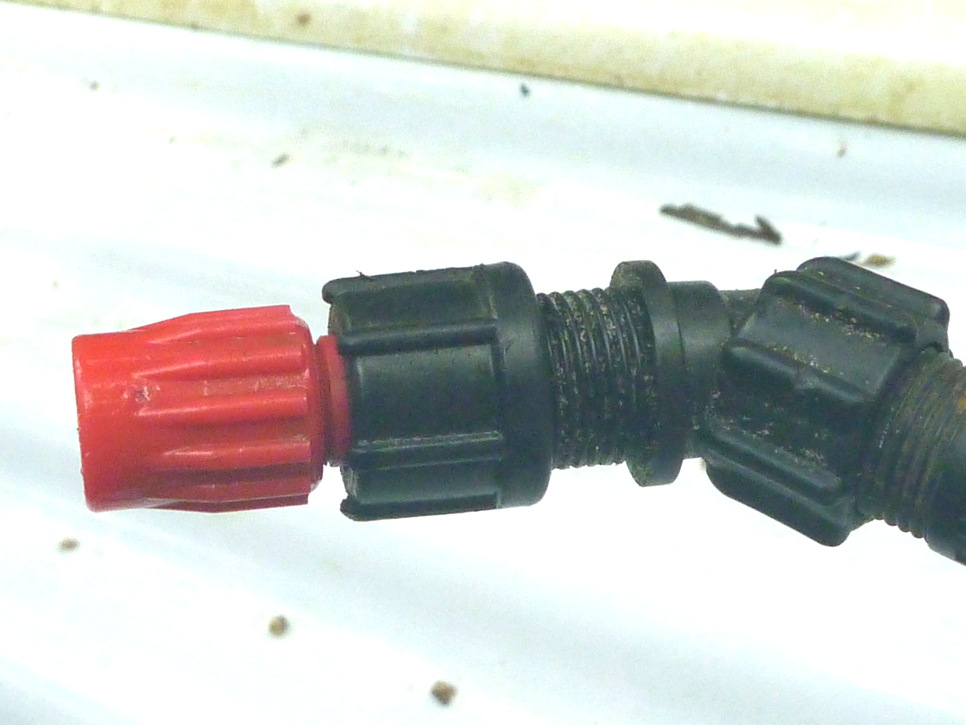The Herbicide
We are also so lucky, that by some biochemical accident, we have a herbicide that knocks out Singapore Daisy, (as well as a host of other soft-leaved weeds)
and appears to have very little impact on grasses and native species. It is also probably the cheapest and least toxic herbicide . This herbicide is metsulfuron-methyl (MSM for short) which goes by a variety of names - MSM 600, Brushkiller, Brushoff, Associate, etc. . It is a granular product, which is used in conjunction with a wetting agent, to ensure that it wets the leaves. You require very little - 0.1 g per litre of spray - which creates problems, as measuring out these quantities can be problematic. The wetting agent is usually 1 ml/litre of spray. As most control efforts will probably use a 18 litre backpack spray, this becomes less of a problem. The herbicide is translocated by the plant, which means that the root system gets killed as well, but sometimes that doesn't occur, and you later find a string of little plants sprouting. This is why regular "spot spraying" of re-sprouts is essential.
(Click here to see our general weed web page)
(Click here for a technical article on the use of MSM)
Hand Weeding
Unfortunately, unless you have very sandy soil and a really small infestation, hand weeding is not advised (or even possible). As each node can put down very extensive roots (and the plant breaks easily at the nodes) you can end up with many, many new plants. Also, Singapore Daisy can produce tiny bulbs at each node, which can remain and produce more plants, so you have to be careful to pull everything up.
Unfortunately, this plant is so aggressive that only chemical control is effective until the infestation is down to a very few individual plants; then hand weeding could be useful.
Other Herbicides
Sadly, although Roundup (glyphosate) seems to still be the "go-to" herbicide, it doesn't work with Singapore Daisy! What it does is cause the Singapore Daisy to drop its leaves (so you think it's dead), and it kills the grass around it. The Singapore daisy recovers, and, as you have killed the grass, it has no competition and rapidly recolonises the area.
Keeping Up!
MSM is a S - L - O - W herbicide, so it may take weeks for the plant to wilt and die. It all depends on the weather. Warm days in springtime are great for spraying as that is when the plant is in full metabolic activity. But really, any warm sunny day is good. Don’t try spraying on cold and cloudy days as your spraying will be less effective. Also: Once is not enough. You need to revisit your spray site at least one more time, no more than six months after your initial spraying and spray the recovery growth again. There will always be “recovery”. It may take two years of six-monthly spot spraying until the plant is exterminated. Sadly, even one surviving plant can re-colonise an area. Take no prisoners! We regard obliterating Singapore Daisy as a process similar to that of a cancer surgeon removing a metastatic cancer.
Mixing and spraying
For practical use we use standard backpack 17 litre sprayers. We use Solo 425s, but any sturdy, saltwater-resistant sprayer will do.

These are great for drier areas, although the mechanism tends to rot (rust) if you're working in beach environments. Cheap and cheerful. Also, you must get an adjustable spray nozzle which can produce a narrow stream of liquid capable of targeting small areas and reaching under other vegetation. The nozzles that the sprayers come with are the"fan jet" type, which is not very good for Singapore Daisy control.

